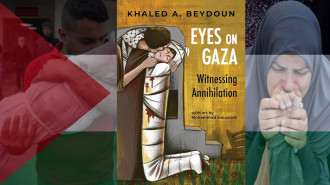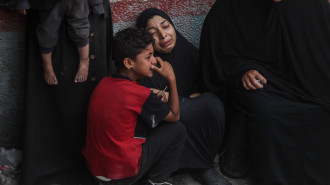
Hollywood’s Gladiator II: Another missed opportunity for authentic North African representation

It's been 24 years since Maximus Decimus Meridius had his vengeance in Ridley Scott's historical epic Gladiator.
Today it is still a world-beloved piece of cinema in which screenwriters David Franzoni, John Logan and William Nicholson wove real-life figures of Ancient Rome into their fictionalised account of a general-turned-slave-turned-gladiator, iconically played by Russell Crowe.
This November, a sequel is headed to cinemas, set potentially 15-20 years after Maximus brushed his way through a wheatfield to the afterlife.
Irish actor Paul Mescal takes over as the lead, playing a grown-up Lucius Verus who first appeared as the child heir to the Roman Empire in the original film set during AD 180.
To begin Gladiator II, David Scarpa, Peter Craig and Franzoni's script has him packed off as a child to Numidia – which today would roughly cover the area of modern western Tunisia and eastern Algeria) in North Africa – by his mother Lucilla (Connie Nielsen reprising the role) to grow up away from the scheming Roman senate.
Lucius has a wife and child but has had no contact with his mother for 15 years. There's also the small problem of Rome, ruled by co-emperors Caracalla (Joseph Quinn) and Geta (Fred Hechinger) wanting to expand their empire further into North Africa.
Fictional Roman General Marcus Acacius (Pedro Pascal) invades the coastal village where Lucius lives and he is subsequently enslaved as a, you guessed it, gladiator.
Denzel Washington is thrown into the mix as Macrinus, described by Scott as "a power broker and arms dealer" who enlists Lucius in his plot to usurp the rule of Rome.
As a critic of mixed British and Tunisian heritage, with a Tanit tattoo on my right forearm, I have more than a passing interest in the representation of North Africa on screen, especially in films set during classical antiquity.
The Carthaginian Empire is "my Roman Empire" but I'm fully aware of Hollywood's annoying habit of white-washing, erasing and/or misrepresenting the Maghreb's history and inhabitants.
Ridley Scott's filmography is far too guilty of that – Gladiator included.
Not only did the 2000 film manage to perpetuate negative stereotypes about Arabs but it also belies their historical movements.
The story introduces grotesque Arabic-speaking slavers who capture an injured and bereaved Maximus at his home in Spain.
Fun fact: there is no evidence that Arab slavers operated in Spain, as confirmed by the Gladiator's historical consultant Professor Kathleen Coleman who was "unpleasantly surprised" when she saw the final film.
"I was under the impression that although the plot was fictitious [Dreamworks] wanted the atmosphere to be authentic," she said. "But that is evidently not the case."
The ugly-looking, Tuarag-wearing slavers take Maximus in a camel caravan to the Roman province of Zucchabar (Miliana in modern-day Algeria) which is presented as a dirty, sweaty, fly-invested burg.
The scene was shot at Ksar of Ait-Ben-Haddou located in an inland village in Morocco. It looks a lot different from the green, mountainous landscape of the region once inhabited by Romanised Amazighs (Berber).
Of course, Hollywood has to portray North Africa as a barren, desert wasteland.
British-Iranian Omid Djalili once again plays a slimy, unscrupulous Arab (remember him in The Mummy?) trying to get a "special price" for his slaves.
He also says he picked up Djimon Hounsou's Numidian Juba from a "salt mine in Carthage."
Juba was a well-known Numidian name — King Juba II was a client king of Numidia and married Cleopatra Selene, the only daughter of Queen Cleopatra VII and Mark Antony.
But given the brazen historical inaccuracies in the film, I wouldn't be surprised if this line is a mistaken reference to the false myth of the Romans sowing the city of Carthage (Ancient Tunisia) with salt after winning the third Punic War – not the salt mines of Carthago Nova (New Carthage) in southern Spain.
A place where we've already established Arab slavers did not operate. A look at the first trailer for Gladiator II, the cast and interviews prove it has already prevented Middle Eastern, North African and Arab actors from playing real-life characters with shared ethnicities.
Let's start with the brother emperors Geta and Caracalla. They are the sons of Septimius Severus and his second wife Julia Domna who briefly shared power after their father died in AD 211.
Severus was born in Leptis Magna, a trading city on the coast of Ancient Libya founded by Phoenician merchants from Tyre/Syria centuries earlier.
It was a prominent municipality in the Carthaginian Empire and when Severus became emperor, he turned it into a thriving metropolis. He had maternal Italian and paternal Punic ancestry and after a few civil wars, was proclaimed emperor of Rome in AD 193.
He was the first North African Emperor and that heritage was so much a part of his identity that the historian Cassius Dio described him as "Libyan by race."
Severus was introduced to Julia Domna, a Syrian woman whose father was descended from the Arab Emesene dynasty.
Her surname is an Ancient Arabic word for "black" and she became Empress. Geta and Caracalla, therefore, would be of mixed ethnicity, mostly Arab-Middle Eastern and North African, but the actors playing them are not.
After her husband's death, Julia Domna became a mediator between her sons but there's no listing of the character on the film's IMDb page nor sign of her in the trailer.
Instead, we have the return of Lucilla who was, in reality, executed in AD 182 for her involvement in the failed attempt to assassinate her brother Commodus.
She appears to be filling Julia Domna's shoes which suggests another MENA character has been sidelined in favour of a white counterpart with history being altered to allow for it.
The trailer suggests Lucius spends time as a child in Egypt prior to Lucilla sending him to Numidia, thanks to pyramids and palm trees in the background of one scene showing him running away from approaching Romans.
Interestingly, Lucilla had two sons called Lucius: one with her first husband Lucius Verus, who died young, and another with her second husband Tiberius, a Roman general, who was murdered by Caracalla.
The film's iteration appears to be a mash-up of them both.
We see a battle on Numidian soil after an attack on what appears to be a coastal fortress, launched by Acacius from the sea. If this is taking place around AD 211, then the Amazigh-nation was already a part of the Roman Province as a client state set up by Septimius Severus.
Why Rome is attacking is unclear unless they are playing with historical timelines again and showing Severus' annexation of various North African settlements – including Castellum Dimmidi, Thabudeos, Gemellae, Vescera and Thubunae – to expand Numidia. But none of these colonies were coastal.
We see a female archer in armour aiming a bow and arrow which may be a nod to several North African legends of female warriors.
Asbyte was a Libyan princess and ally of Hannibal Barca during the Second Punic War, according to Silius Italicus's poem Punica; there were the legendary Scythian warrior women who hailed from Ancient Iran and the famous Amazons who were believed to have once resided in Libya.
She appears to be played by the Israeli actress Yuval Gonen who is listed as the character Arishat (a Phoenician/Punic name) and later seen dead in the arms of Lucius with an arrow through her chest.
If this is his Numidian, Libyan or Carthaginian wife (we see him kissing a woman who looks just like the female warrior towards the end of the trailer) then as with Djimon Hounsou's Juba in the first film, actors with Algerian, Libyan and Tunisian, even Lebanese or Syrian heritage, have been overlooked.
The same goes for Washington's Macrinus. Seemingly based on the real-life figure Marcus Opellius Macrinus, he was a Praetorian prefect in charge of Rome's civil affairs, but of Berber origin and born in Caesarea of Ancient Mauretania (modern Cherchell, Algeria).
Fearing for his life after it was prophesied that he and his son would reign over Rome, he enlisted a Roman soldier to be his "tool" in the assassination of Caracalla, and the film seems to follow suit.
Washington's casting is certainly a better choice than seeing yet another white actor cast as a Roman politician; Derek Jacobi is back as Gracchus with Matt Lucas and Tim McInnerny joining as figures in Rome's elite.
Like Macrinus, the actor has African heritage but Africa is a continent, not a country and too often Hollywood fails to represent the diversity of that fact.
Instead, they opt for racial binaries that limit Ancient figures to black and white. The only North African in the main cast list is that of Egyptian-Palestinian actress May Calamawy. Her casting was announced in May 2023 but she doesn't appear in the trailer and no character information has been shared. So, did she make the cut?
Gladiator II looks set to be yet another blockbuster epic choosing to botch historical facts and project anachronistic ideas about race onto classical antiquity.
The Roman Empire and Roman North Africa was a place and period defined by its ethnic diversity and a throughline of those ethnicities can be traced to the people living across Algeria, Libya, Tunisia, Syria and Lebanon today and in the diaspora.
Unfortunately, people with that ancestry have once again been denied the opportunity to play a role in the commitment of their iconic heritage to cinematic history.
It's the Hollywood story of our lives and I'm tired of it.
Hanna Flint is a film and TV critic, writer and author of Strong Female Character with bylines at Empire, Time Out, Elle, Town & Country, the Guardian, BBC Culture and IGN
Follow her here: @HannaFlint



 Follow the Middle East's top stories in English at The New Arab on Google News
Follow the Middle East's top stories in English at The New Arab on Google News


